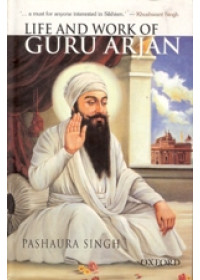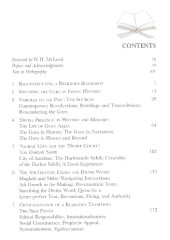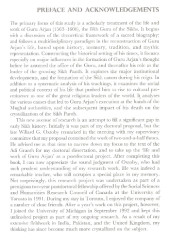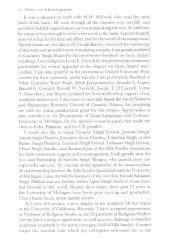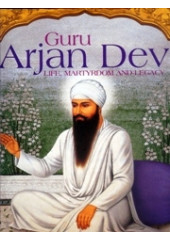Monday to Saturday - 10:00 Am to 9 PM
Now Enjoy Bulk Discounts on Books as Mentioned Below
These Discounts are in addition to the Discounts on Individual Books (Visible as Bulk Discount for Books in Cart)
Extra 10% Off If Books Purchased Exceeds Rs 3000 or 75 USD or 60 GBP or 60 Euro or 100 AUD or 100 CAD
Extra 15% Off If Books Purchased Exceeds Rs 6000 or 150 USD or 120 GBP or 120 Euro or 200 AUD or 200 CAD
Extra 20% Off If Books Purchased Exceeds Rs 15000 or 225 USD or 180 GBP or 180 Euro or 300 AUD or 300 CAD
Extra 25% Off If Books Purchased Exceeds Rs 30000 or 300 USD or 240 GBP or 240 Euro or 400 AUD or 400 CAD
Introduction To The Book 'Life And Work of Guru Arjan' By Pashaura Singh
A comprehensive study of the life and work of Guru Arjan (1563-1606), the fifth Guru of the Sikhs, this volume reconstructs his life based on history, memory, tradition, and mythic representation.
Pashaura Singh focuses on the major influences that shaped Guru Arjan's thought. He discusses the socio-political conditions that moulded the Guru's life, inspiring him to become one of the greatest religious leaders of the world. Presenting a systematic analysis of Guru Arjan's teachings , the author examines the Guru's role as leader of the growing Sikh Panth.
The book discusses major institutional developments and the formation of the Sikh canon during the Guru's reign. It also explores the circumstances surrounding the Guru's martyrdom and the subsequent impact on the crystallization of the Sikh Panth.
This volume, lucidly written and with a multidisciplinary focus, will be of keen interest to students and scholars of religion, especially Sikh studies as also historians, sociologists, and a wide general audience.
Foreword To The Book 'Life And Work of Guru Arjan'
The lives of Guru Arjan and Guru Hargobind have hitherto escaped intensive scholarly investigation and analysis. Guru Nanak and Guru Gobind Singh are well covered, Guru Tegh Bahadur has certainly attracted attention, and there is at least an adequate treatment of Guru Amar Das and Guru Ram Das. Guru Arjan and Guru Hargobind have, however, been somewhat neglected, leaving the field largely to popular narrative or to the brief treatment that one finds in general works covering of larger scope. This is unfortunate. Guru Arjan was responsible for compiling almost all the Adi Granth, and the tenure of Guru Hargobind marks a truly significant change in the history of the Sikh Panth.
Now, however, this pattern is being reversed. We will still lack a scholarly treatment of the sixth Guru, but at least we now have research and discussion of Guru Arjan delivered by the person who stands above all other scholars of the Sikh diaspora as pre-eminent in the area of Adi Granth studies. Pashaura Singh has already published two books on the Adi Granth, The Guru Granth Sahib: Canon, Meaning and Authority (2000) and The Bhagats of the Guru Granth Sahib: Sikh Self-definition and the Bhagats Bani(2003), both of them issued by Oxford University Press in New Delhi. Now he delivers a work on the Guru who was responsible for producing most of the Adi Granth, as well as other features in life of Guru Arjan. This is indeed fortunate for those who seek an understanding of the life and works of Guru Arjan, the Guru who wrote that sublimely superb composition Sukhmani Sahib, and much more besides.
Pashaura Singh first came to my notice during his period of working in Calgary. He was born and brought up in the village of Sudhar in Ludhiana District, did his BSc from Panjab University, and subsequently an MA in Religious Studies from Punjabi University in Patiala. His first full-time job was as head of Religious Studies in Guru Harkrishan Public School in New Delhi, where he taught Sikh history and religion. Evidently he caught the eye of Sikhs from Calgary who were seeking someone able to head their programme , and in 1980 he moved to Canada. In Calgary he worked at the Guru Nanak Centre, partly as principal of the Punjabi school and partly as Granthi ('reader') for the local Sangat ('congregation') While discharging these duties, he also found time to do an MA in Religious Studies from the University of Calgary, and it was as the external marker of his thesis that I first became aware that Calgary had indeed discovered a highly promising person.
In 1987 Pashaura Singh moved to Toronto to begin a PhD at the University of Toronto. In 1988 I began the practice of working at the university for one semester each year while continuing the other semester in my regular position at the University of Otago in New Zealand . This brought me in close touch with Pashaura Singh, and I remained at the University of Toronto until he had completed his PhD. The subject for his dissertation was 'The Text and Meaning of the Adi Granth'. This was an excellent work, and Oxford University Press readily agreed to publish a revised version of it. Pashaura Singh recieved an appointment at the University of Michigan, which eventually became that of Senior Lecturer in Sikh Studies and Punjabi Language.
Some members of the Sikh community took exception to what he had written in the meanwhile, and he was summoned to appear before the Akal Takhat in Amritsar. There he maintained both the truth of what he had written and his right to say it. He accepted punishment, but only insofar as he had upset other Sikhs. There was no suggestion that what he had written was wrong.
This year Pashaura Singh accepted appointment as Professor of Religious Studies at the Riverside Campus of the University of California. It is an honour richly deserved, and the University of Califonia at Riverside will find that an excellent choice has been made. The appointment conveniently coincides with the acceptance for publication of the present work on the life and teachings of Guru Arjan. Life and Work of Guru Arjan is being published in a highly significant year, 2006 being the fourth centenary of the death of the Guru, who was cruelly executed while being held by the Mughal authorities in Lahore. It is altogether impossible to imagine a more auspicious date for the publication of such a book. Pashaura Singh deserves esteem for the release of the book as his tribute to the fifth Guru. He also deserves high praise for the quality of research and analysis which the book contains.
It is with the greatest of pleasure that I commend the book to various readers. It will be of interest to anyone who likes a well-crafted book based on careful research, particularly to those concerned with the history of religions. Its greatest appeal, however, will be to other members of the Sikh Panth. Pashaura Singh has had their interests very much in mind, and this work delivers the result in terms which are judicious and thoroughly convincing.
W. H. McLeod
Emeritus Professor, University of Otago, New Zealand
PREFACE AND ACKNOWLEDGEMENTS
The primary focus of this study is a scholarly treatment of the life and work of Guru Arjan (1563-1606), the fifth Guru of the Sikhs. It begins with a discussion of the theoretical framework of a sacred biography; and follows a multidisciplinary paradigm in the reconstruction of Guru Arjan's life, based upon history, memory, tradition, and mythic representation. Constructing the historical setting of his times, it focuses especially on major influences in the formation of Guru Arjan's thought before he assumed the office of the Guru, and thereafter his role as the leader of the growing Sikh Panth. It explores the major institutional developments, and the formation of the Sikh canon during his reign. In addition to a systematic analysis of his teachings, it examines the social and political context of his life that pushed him to rise to cultural pre-eminence as one of the great religious leaders of the world. It analyses the various causes that led to Guru Arjan's execution at the hands of the Mughal authorities, and the subsequent impact of his death on the crystallization of the Sikh Panth.
This new avenue of research is an attempt to fill a significant gap in early Sikh history. Initially it was part of my doctoral proposal, but the late Willard G. Oxtoby remarked in the meeting with my supervisory committee that my proposal contained the work of two-and-a-half theses. He advised me at that time to narrow down my focus to the text of the Adi Granth for my doctoral dissertation, and to take up the 'life and work of Guru Arjan' as a postdoctoral project. After completing this book, I can now appreciate the sound judgment of Oxtoby, who had such prudent understanding of my research work. He was indeed a remarkable teacher, who still occupies a special place in my memory. Not surprisingly, this research project was undertaken as part of a prestigious two-year postdoctoral fellowship offered by the Social Sciences and Humanities Research Council of Canada at the University of Toronto in 1991. During my stay in Toronto, I enjoyed the company of a number of close friends. After a year's work on this project, however, I joined the University of Michigan in September 1992 and kept this unfinished project as part of my ongoing research. As a result of my extensive fieldwork in India, Pakistan, and the United Kingdom, my thinking has since become much more crystallized on the subject.
It was a pleasure to work with W.H. McLeod, who read the early draft of this study. He went through all the chapters very carefully and provided helpful suggestions at various points along the way. In addition, he was generous enough to write a foreword to the book. I am profoundly grateful to him for his time and effort, and for the words of encouragement. Special thanks are due also to N. Gerald Barrier, who read the manuscript of this study and provided some stimulating remarks. I am greatly indebted to Gurinder Singh Mann for his constructive feedback on Guru Arjan's teachings. I am obliged to Louis E. Fenech for his penetrating comments, particularly his critical appraisal of the chapter on Guru Arjan's mar-tyrdom. I am also grateful to the anonymous Oxford University Press readers for their extremely useful reports. I am particularly thankful to Nikky Guninder Kaur Singh, Mark Juergensmeyer, Donald S. Lopez, Harold G. Coward, Ronald W. Neufeldt, Joseph T. O'Connell, Verne A. Dusenbery, and Karen Leonard for their unflinching support of my academic endeavours. I also want to especially thank the Social Sciences and Humanities Research Council of Canada, Ottawa, for providing me with the initial postdoctoral grant for this project. Appreciation is also extended to the Department of Asian Languages and Cultures, University of Michigan, for the summer research grants that made my visits to India, Pakistan, and the UK possible.
I would also like to thank Virinder Singh Grewal, Jaswant Singh, Amrik Singh Chattha, Jaswinder Kaur Chattha, Trilochan Singh, as also Baldev Singh Dhaliwal, Gurmale Singh Grewal, Lashman Singh Grewal, Chain Singh Sandhu, and Raman Kaur of the Sikh Studies Association for their continuous support and encouragement. I will greatly miss the love and friendship of Satnam Singh Bhugra, who passed away unexpectedly last year. He was one of the signatories of the memorandum of understanding between the Sikh Studies Association and the University of Michigan. I also cherish the memory of my two close friends Sulakhan Singh Dhillon and my brother-in-law Iqbal Singh, both of whom have bid farewell to this world. Despite these losses, these past 13 years at the University of Michigan have been quite exciting and productive. I have learnt much about human nature.
As I write this preface, a new chapter in my academic life has begun at the University of California, Riverside. I have accepted appointment as Professor of Religious Studies in the Department of Religious Studies. For me this is a unique opportunity, as well as a new challenge to establish academic standards in the newly emerging field of Sikh Studies. I cannot forget the warmth with which my colleagues welcomed me to the department. I am particularly grateful to Dean Joel W. Martin, June E. O'Connor, Ivan A. Strenski, Vivian-Lee Nyitray, Michael Feener, Andrew Jacobs, and Justin McDaniel. They make an excellent team of scholars and I look forward to working with them in the years to come.
I acknowledge with warm thanks the moral support received from Narinder Singh Kapany, Chairman of the Sikh Foundation, Palo Alto (California), and Harkeerat Singh Dhillon, Chair of the UCR Campaign for Sikh Studies. Both provided me unflinching support to develop the Program of Sikh Studies at the University of California, Riverside. I am gready indebted to the family of Amarjeet Singh Grewal, particularly Kuldip Kaur Grewal and Amanjeet Singh Grewal, for their hospitality during my stay with them. They made my transition from Michigan to California so smooth that I had no difficulty in settling down in a new environment. I am also grateful for the support and encouragement of Gurcharanjit Singh Attariwala, Gurdev K. Attariwala, Harcharan Singh Sanghera, and Dhanwant Singh Mundae.
My children Manpreet Kaur, Maninder Pal Singh, Kamaljit Kaur, and Kiratpreet Kaur have been a constant source of inspiration. I warmly acknowledge their unflinching love and support. My special thanks go to Maninder Pal Singh for drawing the map of the Sikh sacred geography for this study. He is always just a phone call away from helping me with any technical problem related to my computer. Finally, my wife Baljeet Kaur deserves my special mention for her unfailing love, support and care during this whole period of research and writing. To express my eternal gratitude, I dedicate this book to her, appreciating her smile with those discerning eyes (salonari) that have the power to look beyond this mundane world.
Singh University of California,
Riverside
From the Backcover of the Book 'Life And Work of Guru Arjan' By Pashaura Singh
'I have been most impressed by Pashaura Singh's work ... Guru Arjan has received scant attention from reputable scholars. Pashaura Singh ... does much to fill that gap'.
- W. H. McLeod, Emeritus Professor , University of Otago
'...a definitive study on Guru Arjan and his times ... combines careful study of documents with a balanced account of historiography and numerous issues relating to Arjan. The book ... should remain the standard assessment of a pivotal phase in the emergence of Sikhism as a world religion'.
-N. Gerald Barrier, Emeritus Professor, University of Missouri
Table Of Contents Of The Book 'Life and Work Of Guru Arjan' By Pashaura Singh
| CONTENTS | ||
| Foreword by W. H. McLeod | ix | |
| Preface and Acknowledgements | xi | |
| Note on Orthography | xiv | |
| 1 | RECONSTRUCTING A RELIGIOUS BIOGRAPHY | 1 |
| 2 | SITUATING THE GURU IN INDIAN HISTORY | 14 |
| 3. | VECHILES TO THE PAST: THE SOURCES | 28 |
| Contemporary Recollections; Retellings and Transmissions; | ||
| Remembering the Guru | ||
| 4 | 'DIVINE PRESENCE' IN HISTORY AND MEMORY: | |
| THE LIFE OF GURU ARJAN | 64 | |
| The Guru in History; The Guru in Narratives; | ||
| The Guru in History and Beyond | ||
| 5 | 'SACRED' CITY AND THE 'DIVINE COURT': | |
| THE DARBAR SAHIB | 105 | |
| City of Amritsar; The Harimandir Sahib; Centrality | ||
| of the Darbar Sahib; A Lived Experience | ||
| 6 | THE ADI GRANTH: FIXING THE DIVINE WORD | 134 |
| Mughals and Sikhs: Navigating Interactions; | ||
| Adi Granth in the Making: Pre-canonical Texts; | ||
| Inscribing the Divine Word; Quest for a | ||
| Letter-perfect Text; Recensions, Fixing, and Authority | ||
| 7 | CRYSTALLIZATION OF A RELIGIOUS TRADITION: | |
| THE SIKH PANTH | 172 | |
| Ethical Responsibility; Institutionalization; | ||
| Social Constituency; Prophetic Appeal' | ||
| Systematization, Egalitarianism | ||
| 8 | THE MARTYRDOM OF GURU ARJAN | 205 |
| Politicizing Religion; Mughal Hegemony, | ||
| Peasant Economy, and Resistance; Power and | ||
| Authority; Narrativizing the Martyrdom | ||
| 9 | THE TEACHINGS OF GURU ARJAN | 244 |
| Nature of Ultimate Reality; Conceiving the | ||
| Cosmos; The Spirit of Being; Divine | ||
| Self-expression; The Discipline of the Panth; | ||
| Spreading the Divine Word | ||
| 10 | NARRATING THE PERSON : IMAGES OF THE GURU | 290 |
| Glossary | 300 | |
| Index | 307 |
| Books | |
| Author | Pashaura Singh |
| Pages | 318 |
| Cover | Hardbound |
| Language | English |
Life and Work Of Guru Arjan - Book By Pashaura Singh
- Brand: Oxford University Press
- Product Code: SGE111
- Availability: Out Of Stock
-
Rs.595.00
Related Products
Historical Perspectives on Sikh Identity - Book By J S Grewal
Preface To Book 'Historical Perspectives on Sikh Identity' By J S Grewal Whe..
Rs.125.00
Guru Arjan Dev - Life, Martyrdom And Legacy - Book By Prof. Prithipal Singh Kapur
Introduction to the Book 'Guru Arjan Dev Life, Martyrdom And Legacy' By Prof. Prithipal Singh Kapur ..
Rs.2,000.00
New Insights Into Sikh Art - Book By Kavita Singh
Table of Contents of the Book 'New Insights of Into Sikh Art' By Kavita Singh ..
Rs.2,250.00
Guru Ram Das In Sikh Tradition - Book By Gurudharm Singh khalsa
From The Front Cover of 'Guru Ram Das In Sikh Tradition' By Gurudharm Singh khalsa Guru Ram D..
Rs.400.00
Tags: books guru gobind singh, books on sikh gurus, books on teachings of guru nanak, sakhis of sikh gurus, teachings of guru gobind singh, teachings of sikh gurus life, and, work, arjan, pashaura, english

